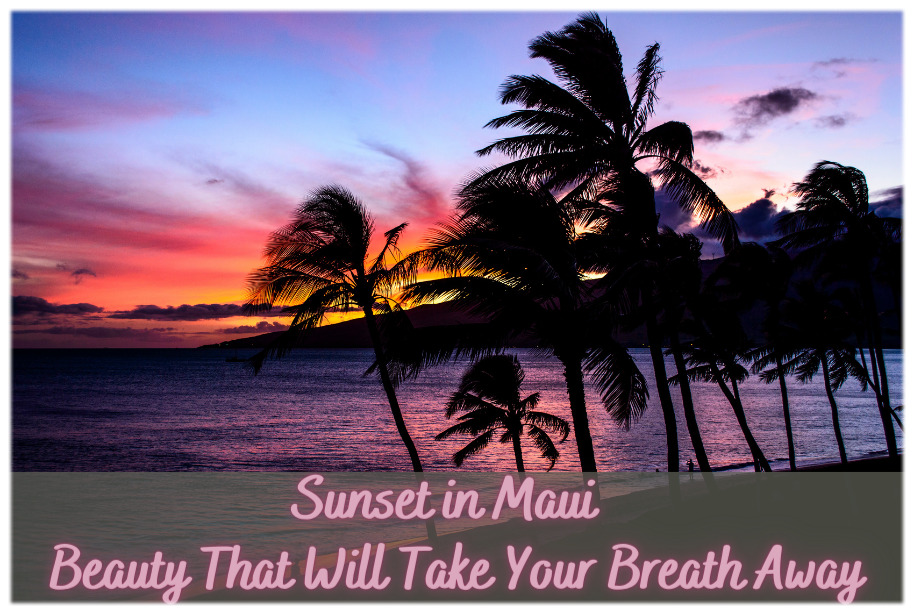
To stop and really witness the sunset is one of the top three reasons to visit Maui. They are just that good. And, Hawaiian sunsets are spectacular, no matter where you are in the island chain.
Since we are on Maui, we will let you in on a few of the secrets of Maui’s awesome sunsets.
Why are Maui Sunsets so Spectacular?
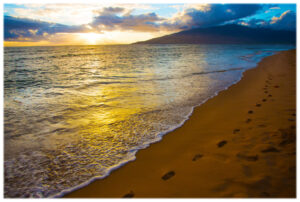
First of all, the brilliant and dramatic colors are the result of a myriad of conditions that can only be found in the Hawaiian Islands.
4 Reasons Hawaiian Sunsets are Unique
- Water vapor, dust, and other gases in the atmosphere spread and magnify the blue and violet light colors in the sky. These colors combine with the other wavelengths/colors of light which all bounce and reflect off the mist. This is how the piercing blue of our sky, particularly to Hawai’i, is created.
- Volcanic dust from the island of Hawaii’s* active volcano migrates up high in the atmosphere. During the day, the particles are spread from the east to the west with our faithful tradewinds, an event that also enhances the sunsets. This is what makes sunsets more dramatic than sunrises. However, sunrise in Maui has its own form of graceful beauty.
- Our location helps. Because we are 20 degrees north of the equator, our temperatures are balmy year-round. These mild temperatures draw a lot of water vapor and humidity from the surrounding ocean into the air. This increased humidity helps to intensify the sunset and sunrise colors. That’s in addition to making your skin soft and your hair curly!
- Being the furthest away from any landmass on earth, there is little atmospheric disturbance, PLUS, the horizon is unobstructed. This, and the sun’s perfect angle over the water makes Maui’s sunsets as good as it gets! Or, maybe better!
The Colors Deepen After the Sun Has Set
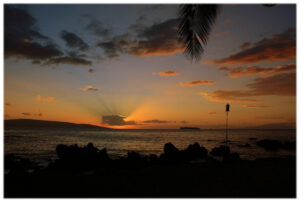
This angle’s steepness provides what is needed to produce the gorgeous deep reds, pinks, and oranges after the sun has set. Meanwhile, flourishing in the rest of the sky are shades of purple and blue, and, sometimes, green and gold. The colors are layered, much like the colors of the rainbow, from lower to higher in the sky and are affectionately known collectively as the Belt of Venus.
We All Know About the Green Flash!
Maui is famous for the Green Flash as well. If you imagine all these elements coming together right when the sun says, “Aloha” and dips below the horizon — a green flash is definitely possible. Just don’t expect it every sunset.
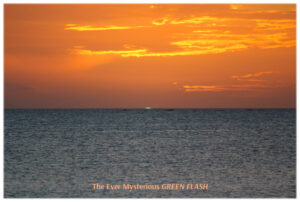
1. Haleakalā* National Park – We have talked about sunrise at the TOP in our blog on The House of the Sun. You can visit our blog about 2 Legends of The House of the Sun and you will be fully prepared for your experience to the top of our mountain.
Sunset at the summit can be more weather dependent than the sunrise. Check out the webcam to be sure. It is fun to check out the webcam anytime, even at night, when the full moon lights up the entire crater!
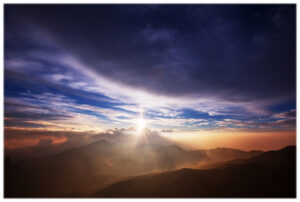
I am sure those words must have come to him as he sailed out of Lahaina at sunset, surrounded by the islands of Moloka’i, Lana’i, and Maui as they lay anchored in the glorious display of sunset colors beyond description. There is something truly magnificent about this view when these different islands are laid out before you, in repose, as they bask in the colors of dusk.
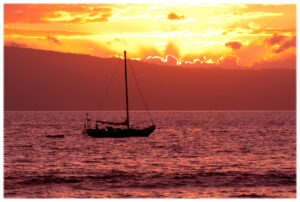
3. Makena* – The beach originally called Oneloa*, is best known today as Big Beach or Makena. Makena is the largest beach on Maui. It is one and a half miles long and can be up to 300 feet wide.
To thoroughly enjoy a Big Beach sunset, we always recommend arriving at least an hour before the sun sets.
This will give you time to have a leisurely swim or walk before you settle back into your beach chairs. Make sure your cooler is waiting with some yummy pupu’s* and favorite libations.
Then, lean back and relax and enjoy one of Maui’s magical moments – the sunset! An experience of beauty that you’ll remember for the rest of your life.
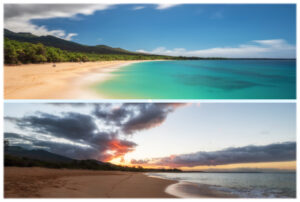
On your next visit to Maui, be sure to put the sunset on the top of your daily To-Do list. No matter where you are – at the beach, at the top of the mountain, or at a nice ocean-front restaurant, take the time to take it in. Put your phone down, and just be. In the distance, you may hear the conch blowing, signaling gratitude to all that is.
Writing and Graphic Design by Sugandha Ferro Black
GLOSSARY* of Hawaiian Words
Haleakalā – 10,000’ high dormant Volcano on Maui, House of the Sun
Hawai’i – also called The Big Island
Makena – abundance
Oneloa – literally, long sand
Pupu – appetizer, snack, or finger food
Windward – Faces northeast and is wet, rainy, and therefore a more lush, green, and tropical section of the island
*Please keep in mind that all Hawaiian Words have many meanings. The meanings we share here are the specific translations for the words as they pertain to this particular blog’s subject matter.
Photos courtesy of paid for or free sources unless otherwise noted.